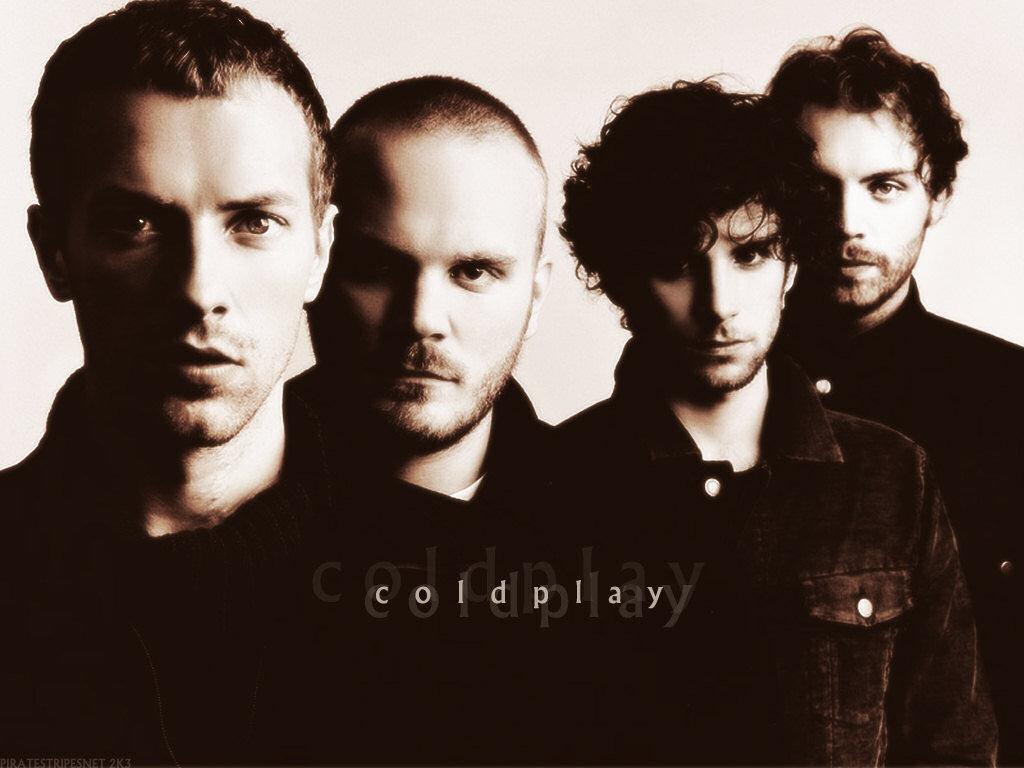Table of Contents Show
Pretty much everyone has heard of Coldplay or has, at least, heard a Coldplay song. After twenty-three years, the band has become internationally recognized and critically acclaimed. Among their many achievements, they have won Best British Group four times, nine Billboard Music Awards, and seven Grammy Awards (though they were nominated thirty-five times) (( “Coldplay.” Wikipedia, 2021. )). Over their many years of production, they have collaborated with the likes of Beyoncé, Jay Z, Rihanna, Big Sean, The Chainsmokers, Tove Lo, and Stromae. Cemented in musical fame, Coldplay has sold over 100 million albums, the same number as Prince, Bon Jovi, Paul McCartney, and more (( “List of best-selling music artists.” Wikipedia, 2021. )).

Coldplay is also the fifth highest-grossing tour group of all time for their “A Head Full of Dreams” Tour from 2016-17 (( “List of highest-grossing concert tours.” Wikipedia, 2021. )). They are more famous and beloved now than ever before, but there is still a strong crowd that dislikes Coldplay’s music. These people may find the band’s hits cheesy, boring, lame, mainstream, not mainstream enough, the list goes on. But there aren’t one or two songs that can ever “sum up” Coldplay’s sound, so it’s difficult to make such a broad assumption about their music from just a couple of tracks. Over time, I’ve delved into the band’s extensive musical history and discovered just how wide of a range their songs have.
Coldplay has evolved musically, just like any other band or artist around for such a long time; alternative, rock, pop, techno, and gospel are just some of the many genres that Coldplay has experimented with over the years. Their songs encompass a range of moods and tempo, and each individual track can pick up, slow down, transition, change form, and pause.
Why Listen To Coldplay?
If you’ve never been big on paying attention to song lyrics, Coldplay might be a good band to listen to. The music itself sets the song’s mood, and the lyrics are a quiet companion. They’re good and relatable, but they’re not the main focus. If you love the specificity of Taylor Swift’s lyrics, keep in mind that Coldplay’s are usually far more general and speak more to an idea or feeling than a specific story. In this way, the music has its own language.

This is more difficult to describe, but I have always felt that Coldplay music is the soundtrack to life. Their songs are powerful, whether they’re fast or slow, and can resonate on a deep level. There is nothing more relatable to the human experience than the many emotions featured in Coldplay songs: love, loss, guilt, pain, happiness, fear, and eternal perseverance. Throughout their many years as a band, they have produced relatable tracks with raw and candid feeling that is not often found in other popular music. They’re credited as being one of the most successful bands in the post-Britpop subgenre, a specific subset of alternative rock that is heavily emotional and incorporates both British and American influences (( “10 Essential Post-Britpop Tracks.” Treble, 2018. )).
One big demarcation between Britpop and post-Britpop was the latter artists’ willingness to clearly sing about love and loss, and deliver it with appropriate melancholy and gravitas
(( “10 Essential Post-Britpop Tracks.” Treble, 2018. )).

Sure, some listeners might not appreciate these powerful moments of emotional clarity or the journey through one’s feelings that often accompanies a Coldplay song. But this music can feel honest and authentic to one’s human experiences in life and make many fans feel seen and understood.
Coldplay’s Albums
Coldplay has released eight studio albums and ten EPs since 1998, as well as a host of singles (( “Coldplay.” Wikipedia, 2021. )). Their albums can be vastly different from one another, but they each still retain the beauty of Coldplay’s signature lilting, emotional style. These album descriptions were created without any background of musical criticism and can hopefully be understood as just a fan’s perspective.
“Safety” (1998), “Brothers & Sisters” Single (1999), “The Blue Room” (1999)
Coldplay’s earliest releases are EPs and singles that are steeped in raw emotion. These songs are weighty, with liberal use of guitar and drums, and can pick up speed and slow down to create a pressing, emphatic sound (“Bigger Stronger,” “Such a Rush,” “Brothers & Sisters”). True to form, the music is dripping with feeling, but can also make the listener feel removed with the use of high vocals and dream-like guitar.
“Parachutes” (2000)
The first studio album of Coldplay’s feels warmer than their EPs, with tracks like “Yellow” and “Sparks,” but still mostly possesses the characteristic moodiness of their earlier music. The majority of the songs aren’t fast; they take their time and seem to lead the viewer down an emotional path to depression (“We Never Change”), then quickly shifting to end on a grand, positive note (“Everything’s Not Lost”), possibly foreshadowing their future endeavors.
“A Rush Of Blood To The Head” (2002)
“AROBTTH” has a similar album structure to Parachutes, almost ending on an impactful yet miserable note (“A Rush of Blood to the Head”) but actually finishing with a slow climb upwards into the light (“Amsterdam”). But this album is probably better known as the one that first introduced the now-famous hits, “Clocks” and “The Scientist.” Overall, “AROBTTH” includes darker, faster-paced tracks, with a genre firmly rooted in rock.
“X&Y” (2005)
“X&Y” is still true to Coldplay’s melancholic rock roots but involves a type of weightlessness, and a distance easily understood from their first track, “Square One.” The piano and organ seem to be utilized alongside guitar, bass, and drums in “X&Y,” as heard in their biggest song of the album, “Fix You.” Thematically, the album revolves around life, confusion, and loss, perhaps best understood in the song “Talk.”
“Viva La Vida Or Death And All His Friends” (2008)
The “Viva” era is definitely the beginning of Coldplay as many of us know them now. The album is marked by bigger songs crafted for a concert atmosphere, with more instrumental elements like differing percussion (powerful drums, bells) and strings. Of course, the partially titular track, “Viva la Vida,” is clear proof of this. This album, as a whole, feels wider and seems to reach farther than Coldplay’s previous records, amplified with the tracks “Lost!” and “Life In Technicolor II,” the latter from the “Prospekt’s March Edition” of the album. The sound out of this record is still emotional but projecting more externally and internationally, as opposed to diving inward.
“Mylo Xyloto” (2011)
Similar to “Viva,” there are many songs on “Mylo Xyloto” that are big, bold, and stadium-filling, such as their hit, “Paradise.” But there are more electronic and pop aspects to the album, and a noticeably lighter, happier tone, easily heard in songs like “Hurts Like Heaven” and “Every Teardrop is a Waterfall.” Additionally, there’s a storyline present, as “Mylo” is a concept album paired with a comic. The album and art inspired by graffiti is bright, colorful, and hopeful.
“Ghost Stories” (2014)
This album was an epic pause on Coldplay’s “big band” sound. “Ghost Stories” is quiet and painful and is perhaps their most reflective and internal album (excluding the EPs). It’s extremely stripped compared to their others; besides their hit, “A Sky Full of Stars,” the overall sound is slow, mellow, and gives one the feeling of drifting, perhaps best represented by the songs “Always In My Head” and “Oceans.”
“A Head Full Of Dreams” (2015)
After the break with “Ghost Stories,” Coldplay jumped right back into their large anthemic songs with “AHFOD.” It’s most similar to “Mylo” but is distinct in its inspiration; “AHFOD” seems heavily influenced by Indian music and art and features multiple guest appearances, as well as the use of a poem titled “The Guesthouse” that is read in the songs “Kaleidoscope” and “Colour Spectrum.” Most songs are positive in tone (“Amazing Day,” “Adventure of a Lifetime”), and this album directly calls upon its listeners to care about each other and “believe in love.”
“Everyday Life” (2019)
This album is probably the most varied of any other Coldplay album, as it is inspired by Middle Eastern music, features an array of genre experimentation, and includes expletives. Here, the band utilizes many different instruments and vocals to produce an album that speaks directly about some social issues of our time (“Trouble in Town,” “Guns”). Most of the songs feel open and wide (“Church,” “Champion of the World”) as if they’re meant to be played outside.
Coldplay Music For Future Fans
Because of Coldplay’s vast repertoire, I believe everyone can find at least one Coldplay song that they enjoy (or tolerate). This list won’t contain Coldplay’s biggest hits because those tend to be their most overplayed songs. Among these hidden gems or less famous tracks, there is hopefully something that speaks to you.
If You Like Rock
- “God Put a Smile Upon Your Face,” “A Rush of Blood to the Head” (2002)
- “White Shadows,” “X&Y” (2005)
- “Violet Hill,” “Viva la Vida or Death and All His Friends” (2008)
If You’re Having An Existential Crisis
- “Bigger Stronger,” “The Blue Room EP” (1999)
- “Talk,” “X&Y” (2005)
- “42,” “Viva la Vida or Death and All His Friends” (2008)

If You Like Pop
- “Lovers In Japan,” “Viva la Vida or Death and All His Friends” (2008)
- “Ink,” “Ghost Stories” (2014)
- “Hymn For The Weekend,” “A Head Full of Dreams” (2015)
If You Like Upbeat
- “Shiver,” “Parachutes” (2000)
- “Hurts Like Heaven,” “Mylo Xyloto” (2011)
- “Birds,” “A Head Full of Dreams” (2015)

If You Don’t Like Chris Martin’s High Notes
- “Green Eyes,” “A Rush of Blood to the Head” (2002)
- “Til Kingdom Come,” “X&Y” (2005)
- “Another’s Arms,” “Ghost Stories” (2014)
If You Like Soft Acoustic
- “See You Soon,” “The Blue Room EP” (1999)
- “Prospekt’s March/Poppyfields,” “Viva la Vida (Prospekt’s March Edition)” (2008)
- “Old Friends,” “Everyday Life” (2019)
If You Want Music To Spur A Crying Session
- “Swallowed in the Sea,” “X&Y” (2005)
- “O (Fly On),” “Ghost Stories” (2014)
- “Daddy,” “Everyday Life” (2019)

Adventure Of A Lifetime
These songs make up only a small percentage of Coldplay’s vast collection, so there is substantially more exploration that’s possible. There are many reasons to give Coldplay a chance, an obvious one being that they are everywhere, literally and figuratively. Their music is frequently played on the radio and in stores. Their songs are featured in movies, TV shows, and even Joe Biden’s inaugural fireworks display. The band members are also active participants in charities, from Amnesty International to Make Trade Fair (( “Coldplay.” Wikipedia, 2021. )).
Additionally, Chris Martin serves as the curator of the Global Citizen Festival, an annual concert benefit featuring famous musicians and celebrities, which is organized by the Global Poverty Project for the purpose of eradicating extreme poverty (( “Global Citizen Festival.” Wikipedia, 2021. )). Coldplay remains in the public eye, producing good music, promoting positivity, and helping the world, regardless of their anti-fans. Possibly a better reason for journeying into Coldplay’s music is to find songs that resonate with you.
Their music is intensely personal yet general, so many of their songs can feel powerful and invoke emotion from an audience without being lyrically bound to a specific circumstance. By listening to Coldplay, you can open your mind to brand-new musical experiences that can also be relatable to your life and maybe even find pieces of your own existential soundtrack along the way.
